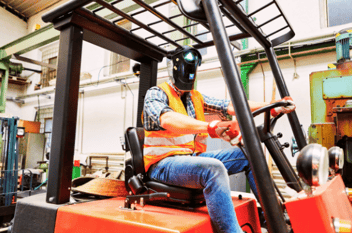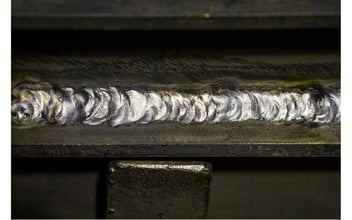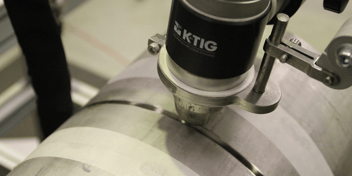Should You Use Automated Welding in Your Welding Program?
.jpg?width=960&height=314&name=NEW%20K-TIG%20QUALITY%20HERO%20JAN%2018-V1%20(1).jpg)
To automate or stay manual? That is the question. With apologies to William Shakespeare, who fused his talents to create lasting works of drama and literature, it is useful to ask yourself this set of questions when deciding whether it makes sense to automate your welding program so you can improve your productivity, quality, and on-time delivery:
1. Do you have many repeat jobs? 2. Do many of your jobs require long, straight welds or involve cylinders continuously rotating during the welding process? 3. Do those jobs use easily weldable, conductive materials? 4. Are thickness and weld penetration depth (WPD) considerations of primary importance? 5. Do the structures you weld have areas that are difficult to reach and finish?
If you answered YES to all those questions, then a K-TIG Keyhole Tungsten Inert Gas welding system could be ideal for your applications.
One of our customers, Primus Pipe & Tube in Wildwood, Florida, made the switch, and they’re extremely pleased with their decision. Primus, located 50 miles northwest of Orlando, specializes in making stainless steel pipes for customers in oil refining, food processing, and other industries. These pipes range from 2”-60” in diameter with a thickness up to 3”.
Using our technology, Primus welds pipes in a single pass, achieving full penetration with no rejects characterized by pipes passing the x-ray test 100% of the time, day after day to improve productivity by 25%. Furthermore, the system integrates seamlessly with the production line.
Another customer, Liquip Victoria, is using our technology to streamline its welding process in the production of more than 50 bulk fuel storage tanks for the Australian Antarctic Division, a government agency that conducts environmental research. These tanks will be put to the test in extreme conditions as temperatures in Antarctica range from a high of -28°C (-18°F) down to -59.5°C (-75.1°F).
As for quantifiable benefits, our customers at Liquip tell us that our system is 3X faster than the conventional welding system they had been using, and that their welds made with our system require less rework and no grinding or beveling. In short, we have enabled Liquip to take the “messy” work out of fabricating.
The benefits of a K-TIG system can give you a significant competitive advantage just as it has done for Primus and Liquip. In effect, you can add an extra shift to your production schedule every day (an operating expense) for what most likely is only a small percentage increase in your one-time machinery acquisition/integration cost (a capital expenditure).
Looking at transitioning to automated welding from another perspective, you are buying the weld and the equipment is secondary. By that statement, I mean you are purchasing the convenience of single-pass welding that requires little or no re-work so you can improve productivity, quality, and turnaround time to an extent that you may not have thought possible.
Although a K-TIG system may be more expensive than the next-best alternative, it is an investment in your company’s long-term future that allows you to combat the welder shortage you may be experiencing and puts your welding program on autopilot. Automation also enables your welding team to focus on tasks that are more challenging and less tedious than the ones they have traditionally performed, and that modification of job responsibilities can help to improve morale.
Does investing in a new welding system when the one you are using is “perfectly good” make sense? It depends: For spot welding or complex shapes, probably not. For continuous welding of common shapes, probably yes. At K-TIG, we are prepared to help you examine the possibilities objectively with your best interests in-mind.
Beyond Technical Considerations
 Transitioning successfully to automated welding requires more than top and senior management imposing changes on members of the welding team. Specifically, a company’s culture must be receptive to change. As the ancient Greek philosopher Heraclitus wrote more than 2,500 years ago, “There is nothing permanent except change.” These days, if a company’s culture is not geared to accepting change as something which is unavoidable and is not able or willing to manage change, it is likely to go out of business.
Transitioning successfully to automated welding requires more than top and senior management imposing changes on members of the welding team. Specifically, a company’s culture must be receptive to change. As the ancient Greek philosopher Heraclitus wrote more than 2,500 years ago, “There is nothing permanent except change.” These days, if a company’s culture is not geared to accepting change as something which is unavoidable and is not able or willing to manage change, it is likely to go out of business.
When it comes to welding, automation is light years ahead of manual processes and “blacksmithing” vessels the old-fashioned way is not sustainable. Our experience has shown us that automated shops produce better quality welds and have quicker turnaround times than shops that continue to “beat things together.” Going forward, the fast – those who automate -- will eat the slow – those who continue to do things the traditional way -- instead of the typical case of the big eating the small.
By transitioning to automated welding, you can improve productivity, quality, and turnaround time, in some instances by more than 80%, from 52 weeks to 8-16 weeks, for example. Most importantly, when you decide to make the switch, you’ll have as much technical support as you need to make your welding program a core strength of your operations. To replicate the success that Primus, Liquip, and so many others are enjoying…


